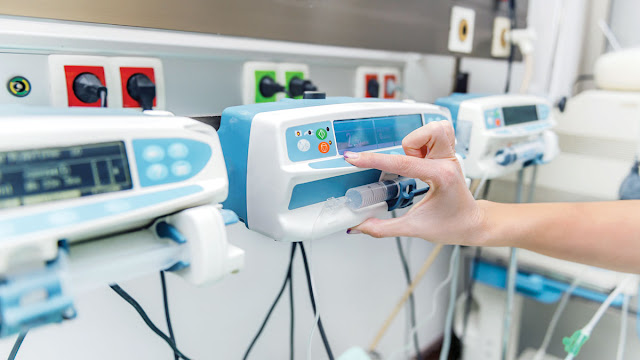Infusion pumps; used to deliver nutrients or medications such as insulin or other hormones, antibiotics, chemotherapy drugs, and pain relievers
An
infusion pump is a clinical tool that offer liquids, such as nutrients and
medicines, into a sufferer’s body in regulated quantity. Infusion pumps are in
vast usage in medical settings such as nursing homes, clinics, and in the
indoor. Generally, an infusion pump is functioned by a trained user, who
regulates the rate and time of liquid delivery from a built-in software
interface. Infusion pumps provide notable benefit during manual administration
of liquids, comprising the capability to transfer liquids in very less
capacity, and the capability to transfer liquids at exactly programmed rates or
automatic duration.
Volumetric
Pumps Segment in the Global
Infusion Pumps Market was valued
at US$ 747.0 Mn in 2018 and is expected to exhibit a CAGR of 4.8% during the forecast period.
They
can transfer nutrients or medicines, such as insulin or other hormones,
antibodies, chemotherapy medicines, and pain sedatives. There are several
forms of infusion pumps, comprising large capacity, patient-controlled
analgesia , elastomeric, needle, enteral, and insulin pumps,. Few are
modified chiefly for stationary usage at a sufferer’s bedside. Others,
known as ambulatory infusion pumps, are modified to be handheld or wearable.
As infusion
pumps are mostly utilized to direct critical liquids, comprising
high-risk medicines, pump failures can have notable executions for sufferer’s
security. Many infusion pumps are tooled with security reasons, such as alarms
or other operative alerts that are envisioned to trigger in the event of a
difficulty. For instance, few pumps are modified to alert consumers when air or
other blockage is identified in the tubing that offers liquid to the sufferer.
Few novel infusion
pumps, generally known as smart pumps, are modified to aware the user
when there is a threat of a negative medicine inoculation, or when the consumer
sets the pump’s parameters outdoor of particular safety restrictions.
For
the past many years, notable security issues associated to infusion pumps have
come to Food and Drug Administration’s attention. These problems
can cooperate the safe usage of external infusion pumps and lead to above- or
below-infusion, missed therapies, or late treatments. From 2005 till 2009, U.S
Food and Drug Administration (USFDA) gained around 56,000 reports of negative
things linked with the usage of infusion pumps comprising various wounds and
fatalities.




Comments
Post a Comment